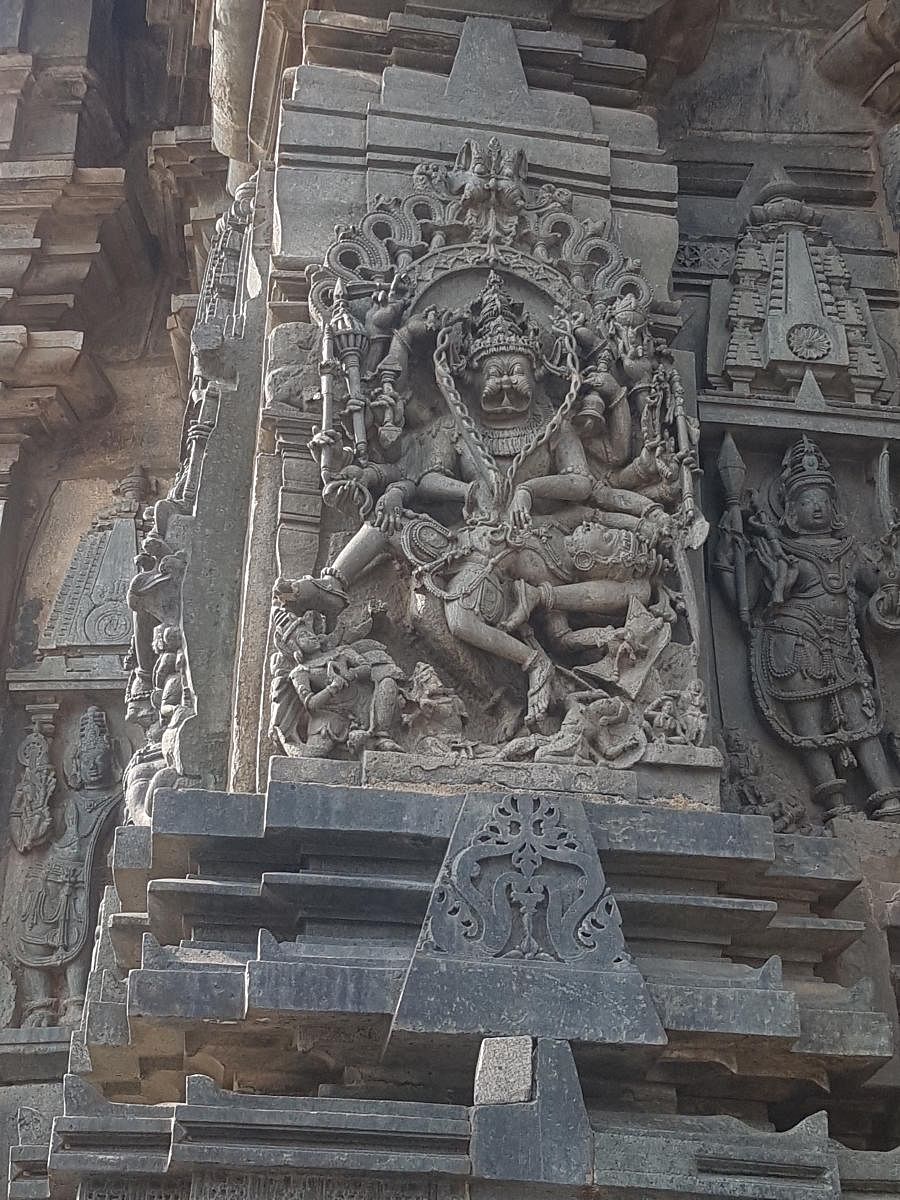

The numerous temples crafted by the Hoysala kings validate that they were great connoisseurs of art and architecture. We decided to visit one of their eminent edifices — the Chennakeshava Temple at Belur which has elegantly stood the test of time. It was late afternoon on a hot day when we reached there and as we edged closer to the gopuram, I was gripped by a sense of déjà vu.
Sculpted exclusively out of stone in the 12th century, the temple complex is quite large and houses several structures besides the main shrine. These structures include Kappe Chennigaraya Temple, a marriage hall and small shrines.
As we ascended the characteristic star-shaped plinth, all the personalities from the pages of the book I had recently read came alive — the warrior king Vishnuvardhana, who had planned and initiated its construction, his talented queen, Natyarani Shantala who was a renowned dancer and an able administrator, and the famed sculptor, Amarashilpi Jakanachari. Rarely do we see such glorification of artisans in history where their names have been inscribed and immortalised.
Predominantly built in the Dravidian style, the main shrine is heavily
embellished with labyrinthine carvings. It is hard to believe that such complex architecture is handmade. No wonder it had taken them 103 years and three generations to complete the structure. The gopuram and some of the external elements were added by the Vijayanagar rulers later on, it is said.
Over the years, when the temple sustained attacks from the Delhi Sultanate rulers, the Vijayanagar kings also made attempts to restore its magnificence.
Intricately engraved
Right above the entrance door of the Chennakeshava Temple, you can witness the mythical bird Garuda, which is flanked by the ten incarnations of Lord Vishnu in a semicircular pattern. The outer walls are festooned with the portrayal of gods, animals, birds, humans, legendary creatures, creepers and flowers. The elephants that carried the stones for construction are featured at the base and represent strength. Each of the friezes and sculptures has an interesting tale to narrate and is burnished to perfection.
Latticework on walls that allows sunlight into the inner hall is conspicuous. At certain spans, there are pillars and at their tops are the shilabalikas or madanikas, which is a distinguished attribute of this temple. Each shilabalika is made out of a separate stone and is affixed to the pillar at an angle by a unique interlocking system. The shilabalikas are exquisitely hewn figurines that exemplify feminine beauty and are bedecked with ornaments.
Manifested in various expressions are the dancers, musicians and commoners, and each sculpture is a sight to behold. Darpana Sundari is one such statuette that is deemed to be the tourism emblem of our state. A girl drying her hair where even the water droplets are shown is another fascinating sculpture.
On close observation, we could perceive the sculptor’s finesse and imagination in capturing and recreating the intimate emotions in stone. Apart from the artistic skill, they also elaborate the attire, hairstyle and the generic mode of life of the bygone era. While the shilabalikas are arrayed on the forefront walls, the hind end is fabricated with the characters and scenes from the Mahabharata and the Ramayana and incarnations of Lord Vishnu. In an image where Lord Narasimha slays king Hiranyakashipu, it is stunning to note how the most profound details like the sharp tooth and the fingernails digging into flesh have been depicted.
Likewise, Varaha avatar is also impressive. Lord Shiva is pictured as Gajacharmambaradhari where he dances inside the elephant demon’s belly and wears its skin. There is so much attention to detail that even sketching these icons would seem complicated.
With the peripheral design itself reflecting such grandeur, obviously the interiors have to be even more remarkable. Each of the 48 extravagant pillars that uphold the dome-shaped convoluted ceiling is different from the other and is a masterpiece in itself. The largest of all impersonates the entire temple and is phenomenal. One of the pillars is said to have generated music and another was rotational too. At the centre of the hallway is the stage of
Natyarani Shantala.
The glowing shilabalikas at the top of the pillars here have a metallic finish and exhibit graceful dance poses and are aesthetically adorned. From hair accessories to bangles, necklaces, armlets, waistbands, anklets and toe rings, the Hoysala women wore them all.
Unmatched skill
What’s more is that in some of the statues, the bangles and other jewels are cut out in such way that they can be moved! The splendid pieces of art have to be seen to be believed and appreciated. Just outside the sanctum sanctorum, there is an idol of Lord Vishnu donned as Mohini. Within the inner shrine, stands the six feet tall, sublimely beautified cult idol of Chennakeshava who is the chief deity of the temple.
Through all the myriad etched tales and written inscriptions, the Chennakeshava Temple at Belur is where the Hoysala grandeur and legacy linger on. Before leaving, I glimpsed at the marvelous spectacle one more time and then at the countless visitors, both Indians and foreigners, and my chest swelled with pride at the rich heritage of our land.